The Sync Books – What a Trip!
One of the goals of my 12-Week Challenge was to read and study three books.
Yesterday I finished the final unread chapter of The Sync Book 2.
I had saved Joe Alexander’s ‘The Blur’ for the end of the journey (so to speak).
In this post I will share some of my thoughts about the two Sync Books and the broader Sync Book operation.
I will also explain why I would recommend these books to anybody interested in the kind of content found on my site.
Article #33
The Sync Books – What a Trip!
Published 2-Dec-2017
Contents
1 – An Amazing 12 Weeks
2 – Synchromysticism and Synchronicity
3 – The Sync Book and The Sync Book 2
4 – The Authors
5 – Sync Hunt
6 – Multimedia
7 – My Personal Favourites
8 – A Personal Sync
1 – An Amazing 12 Weeks
The Sync Books have played a key role in what have been twelve of the most eye-opening weeks of my life.
Earlier this year, I suggested to the audience of this website that we may, as individuals and as a group, benefit from challenging ourselves to improve our own lives in an objective and meaningful way.
Article #26: Challenge Yourself (1-Sep-2017)
Post #1: 12-Week Challenge: Open Thread (10-Sep-2017)
My logic is simple: if we cannot improve our own lives in an objective and meaningful way, then how could we possibly believe for even one second that we could help others in objective and meaningful ways?
The ‘alternative’/’conspiracy’/’truth’ (ACT) realm in which we operate is populated by lemmings who seem to genuinely believe that by merely ‘knowing about’ certain deceptions, they have somehow improved their lives. As if this is not deluded enough, the same people tend to believe that by spreading their ‘knowledge’ they can somehow ‘help’ others (and even ‘fix’ the world).
I cannot judge such people for their naivety; I fell into some of these fallacious beliefs myself when I was new to the ACT realm.
I can however describe these people as lemmings because this is precisely what I was (and what they still are): lemmings who parrot (to themselves and to others) the mantra that merely talking and ‘knowing’ about the deceptions will somehow lead to positive change (on the micro and/or macro level).
Having spent several years observing and studying the behaviour of myself and others I now see things much, much differently.
The reality is this: if we have not improved (in meaningful and objective ways) our own lives with our newfound ‘knowledge’ then it is insane to believe that our ‘knowledge’ can or will help anybody else. Truly insane.
The 12-Week Challenge, therefore, was designed as an opportunity to explore and test my theory that the alleged, practical benefits of ‘truth’ are overstated at best and entirely fabricated at worst.
A more thorough review of the Challenge is beyond the scope of this article. Those interested to learn more are encouraged to check the article and/or post linked above.
The relevance here is this: it was my task to read and complete both Sync Books (and Alan Moore’s Watchmen) in the space of twelve weeks. To say that it has been a trippy three months would be a substantial understatement. I’ll never be the same again.
And if you continue on with reading the rest of this article, and seriously engaging with the concepts explored, then you might never be the same again, either.
Don’t say I didn’t warn you…
2 – Synchromysticism and Synchronicity
Jake Kotze, the man who takes credit for coining the term ‘synchromysticism’, describes it as thus:
“The art of realizing meaningful coincidence in the seemingly mundane with mystical or esoteric significance.”
Those who are not already familiar with ‘sync’ are encouraged to check out the following piece:
Article: An Introduction to Synchromysticism (3-Apr-2017) [Public]
The internet is home to literally thousands of blogposts and videos which attempt to explore the concept of ‘sync’.
Two of my personal favourites are embedded below:
‘Back to the Future Predicts 9/11’ by Joe Alexander (a.k.a. Apophenia Productions)
‘Moonkey’ by StArmy (a production of Jake Kotze)
If none of the three video listed above have managed to pique your interest in ‘sync’ then you might as well stop reading this article now.
I’m not joking.
3 – The Sync Book and The Sync Book 2
Published in 2011 and 2012 respectively, these books represent what I would describe as the high water mark of ‘synchromysticism’.
Coming to prominence circa 2007, a small online community of ‘synchromystics’ were busy writing sync blogs and creating sync videos.
Then in 2011 an American man named Alan Abadessa-Green, aged in his early thirties at the time, encouraged his fellow ‘sync-heads’ to partake in a novel project:
A book dedicated to exploring sync, to be comprised of 26 chapters, each by a separate author, giving his or her own unique perspective on the phenomenon.
Green volunteered to edit and publish the book himself. On September 11, 2011, the project came to fruition, and The Sync Book was born.
This then led to a sequel, The Sync Book 2, with the same format and an entirely new collection of authors, published on November 26, 2012.
Abadessa-Green partook in a number of promotional interviews with various ‘alternative media’ figures including Red Ice Radio.
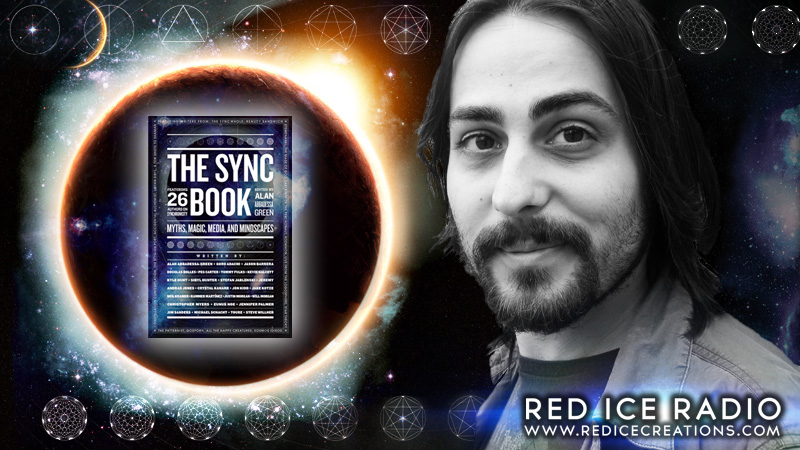
A third and final edition of the series was mooted but has not yet been published, and appears to be in ‘development hell‘.
For the time being, the two existing Sync Books constitute a significant and remarkable contribution to independent media and thought.
4 – The Authors
Many of the individuals involved in the books were what one might describe as hobbyists or amateurs: bloggers and YouTubers who create(d) sync content merely for fun and/or as a form of artistic expression.
Most of this group were well-known within the ‘sync community’ prior to publication of the books. Some had built sizeable audiences at their blogs and YouTube channels, whereas others were relatively obscure even to fellow ‘sync heads’.
Abadessa-Green was also wise enough to involve a number of individuals who were only tangentially (if at all) related to or involved in ‘sync’, but whose prior work would help generate an air of authority and potential readership which any independent publication can benefit from.
For example, you may be familiar with names like Freeman Fly and Neil Kramer, well-known in the ‘conspiracy’ and ‘spirituality’ scenes respectively.
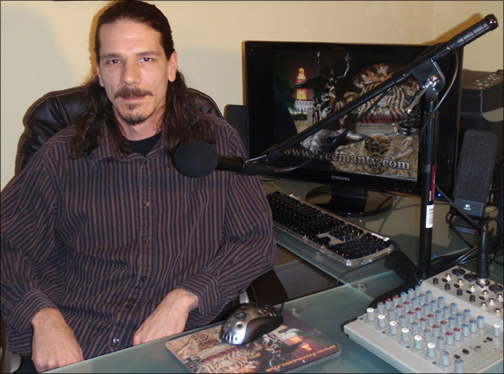
Many of the authors featured across the two books were already authors in their own right, whose prior work ranges in scope from non-fiction analysis of ‘copycat killing’ to Forteanism to backpacking to UFOlogy to psychology and on and on.
Put simply, the authorship across the two books is nothing if not diverse.
This is the brilliance of Abadessa-Green’s concept: with so many different individuals giving their own take on ‘sync’, the reader is bound to be met with perspectives familiar and unfamiliar, affirming and challenging, relatable and unrelatable, attractive and repulsive.
Just like any serious exploration of sync itself.
By its very nature, sync is a difficult topic/concept/field to boil down to one explanation or analysis or account or perspective.
If any line of inquiry is suited to a multi-author format, it is sync.
Amusingly, some of the authors went on to make names for themselves in rather different fields post-The Sync Book.
For example, Kyle Hunt, author of a chapter entitled ‘The Raindbow Alphabet’ in TSB1, went on to become a leading ‘white nationalist’* and now runs his own internet radio station, much to the chagrin of Abadessa-Green (who disowned any involvement with Hunt henceforth).
*Those who are not already familiar with the work and ideas of ‘white nationalists’ may find this confronting. It is my experience that ‘white nationalists’ are usually just race realists who wish no harm upon any other race, and are instead focused on trying to slow/halt the dilution of the white race. There are of course exceptions, which is one of the reasons I don’t personally identify with their ‘movement’.
5 – Sync Hunt
When I first started creating my own independent content (by way of the Australian Roundtable Podcast) in 2014, I was a regular listener of Hunt’s weekly Solar Storm podcast. At the time I had no idea that, before he became a vocal ‘white nationalist’, Hunt had operated a blog concerned with what I would later learn can be broadly described as ‘sync’.
Put another way, I arrived at sync after several years of investigating various alternative ideas and fields, and Hunt’s race realism (and related) work was an important stepping stone for me along the way. I would go so far as to describe Hunt as an early inspiration of mine (even if I no longer listen to Renegade much these days, for reasons beyond the scope of this article).
Imagine my amusement when I discovered that Hunt had, in some respects, taken the same path as myself but in the opposite direction. Whereas my journey had taken me from race realism to sync (with many other steps along the way, of course), Hunt’s journey had taken him, one way or another, from sync to race realism.

The irony of all of this is that in 2014 I was still stuck in a largely materialistic/physicalist/reductionist framework, and if Hunt had been talking about sync on his Solar Storm podcast, I probably would never have become a regular listener. It was only after I made my through the Hoax Hierarchy that I began to genuinely open my mind to new ways of thinking and exploring what we call ‘reality’.
This is one of the great strengths of the The Sync Books: the authors appear to have been encouraged by Abadessa-Green to share accounts of their own journeys through life, and specifically their progression through the world of alternative ideas, conspiracy, and ‘truth’. Reading the ‘meta’ reflections of others can encourage and even provoke us to pause and contemplate our own paths, to contrast where are today with where we were before and what (if anything) we have truly gained from the experience.
6 – Multimedia
There is more to The Sync Book than the The Sync Books. Following the publication of the first edition, Abadessa-Green went on to create and build a multimedia platform which hosts videos and podcasts dedicated to further exploration of sync.
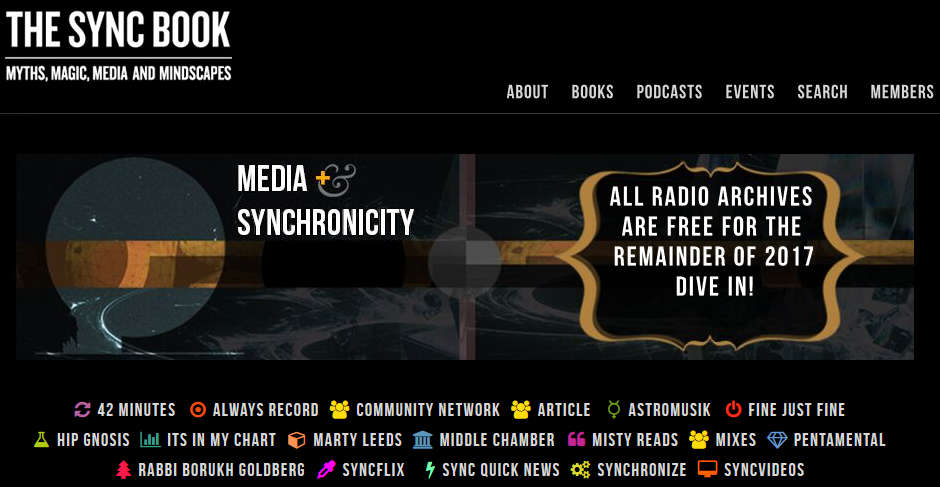
Here is, in my opinion, the best part: most of the authors who contributed to The Sync Books subsequently took part in interviews for various SyncBook-dot-com podcasts. This means that those who want to do so can engage in an immersive journey through the books and thus through the field of sync itself.
In my own case, I would read a chapter or two of The Sync Books on the train on the way to/from work, and then over the followings days listen to the relevant podcasts while going for my regular walks around the hills of Brisbane. I tried my best to avoid listening to each author’s interviews until after I had read and assessed each chapter in its own right, so as to not bias or colour my judgement of the written work.
Sometimes I would read a chapter and think ‘this guy is an idiot’, only to find that in his/her interviews the individual concerned came across as anything but.
Of course, sometimes the opposite also proved true: I would read a chapter and think, ‘wow, I have found something special here’. Then I would download their interview(s) with anticipation, leave my house and begin my daily walk full of excitement, and soon find myself wondering, ‘how could such an insightful writer turn out to be such a terrible speaker?’
Rare is the case of the brilliant author and speaker, but I can assure you that there are several to be found among the Sync Book stable. In the next section I will briefly discuss some of my personal favourites.
Here is the key point to take away from this section: the multimedia nature of the wider Sync Book operation, when coupled with the multi-author format of the books, makes The Sync Books something very different from most if not all of the books you are likely to have read before — as if a central focus on sync does not make the books unique enough already.
7 – My Personal Favourites
It was my mission to not merely read but study both of the The Sync Books. I have put together a summary and assessment of every chapter which I will release on this site in due season.
Part of my assessment included a basic five-star rating of quality, entirely subjective, for my own purpose of evaluation and reflection.
My ratings are based purely on my first reading of each chapter, on the content of the chapter alone, and completely independent from other material (such as podcasts involving the author).
By the time I finished the two books, five chapters had been awarded top marks. It is my belief that any intelligent, open-minded person with even a cursory interest in sync would be able to take something away from reading these chapters (and thoroughly enjoy the experience).
Below is a short snippet from each of those five chapters. Beginning in early 2018 it is my intention to provide comprehensive analyses of each of these chapters (and several others).
For now I hope that the passages provided give you some insight into what The Sync Books — and synchromysticism itself — are all about.
In order of their appearance in The Sync Books:
Jeremy Knight – The Sync Book 1, Chapter 3
Those who practice synchromysticism tend to follow the same basic assumption that no source of information is off-limits. One blog article might connect a news headline from the Internet to: tarot cards, the zodiac, events in history, word etymology, the meaning behind a person’s name, music videos, and areas of conspiracy research. Synchromysticism can be used to find meaning in situations where that meaning might not have been implied or even originally intended. I would say that there are similarities to the art of divination because it is the observer who finds the meaning in the randomness.
I believe it takes an observer to bridge the subjective and objective, symbol and meaning, heaven and earth, and bring synchromysticism into existence. That is to say, maybe contrary to other opinions on the matter, that synchromysticism doesn’t exist ‘out there’ in a mish-mash of random information all too available these days via the Internet, waiting for us to find it. I think only the potential is there, like the void before creation, and that by discriminating amongst an overabundance of information, an individual perspective will cause part of the abyss to coalesce into solid creation unique to its observer creator.
Andras Jones – The Sync Book 1, Chapter 8
To the outside observer, leading a synchromystic life may appear as a brand of madness or enlightenment or simply as being “lucky” (good and bad luck included). From inside of the experience, I can report that synchronicity does not change the fact of Buddhism’s four noble truths, but it does open us up to a much larger playing field in which to experience the joys and sorrows which make human existence, well, human. Synchronicity expands the possibilities while cutting off most of the psychological escape routes. Once we realize that the world as we experience it is singing our reflections back at us all the time, it makes it very hard to blame anyone else for our predicament or, for that matter, to deny our own power (although most us still try).
Kevin Halcott – The Sync Book 1, Chapter 15
I propose that the pop-films that we share and enjoy in our modern times are also metaphoric initiatory tattoos or expressions denoting our dramatic movement into deeper union with the infinite and ourselves. Just as we used to embrace our initiatic mythologies of the Gods or the forces of nature into the Stars of the night sky, we now have our dramatic mythology supplied to us by the move stars of the silver screen.
The Art of Synchromysticism acknowledges the significance of what we call movie “Stars” on planet Earth as being intimately and symbolically connected with the same dramas that have been recorded in the stars above since the since the dawn of storytelling. Let’s consider that this is the journey of cinema and mythology, the externalization and documentation of the mythic, spiritual, and social drama of self-realization and celebration of the spectrum of the experience of life in symbolic form.
Jake Kotze – The Sync Book 1, Chapter 21
The word coincidence is generally associated with thing-events that echo one another through chance. The decision that something is chance or more mysterious also lies in the murky phantom world of opinion. Synchronicity and coincidence are the same thing, only the individual bias over whether the relationship is meaningful or arbitrary changes. Two people will witness the same events and one will call it coincidence and the other sync.
….
All understanding is sync, which is simply association, relationship or connections between thing-events. We derive meaning from putting things and events together to tell ourselves a story.
…
The more we allow ourselves to notice sync, the less barriers there are and the more our depth of perception will grow, allowing us to penetrate deeper into the world — a world which starts to feel inseparable from what we consider ourselves.
…
Investigating sync leads one, not only to relaxing the boundaries between things and events, but also to letting go of the rigid classifications of these thing-events. In order to notice that one thing-event (situation, object or symbol) has an affinity to another, often means being “loose” with our associations. In a sense, to see and understand sync we must become fools — free from the limitations, but not the benefits, of mind.
Dr. Kirby Surprise – The Sync Book 2, Chapter 10
Modern western societies ignore SE (synchronistic events). We don’t teach children about the connection between their inner and outer worlds. If they are very young, we allow “magical thinking” and tell them stories about how wishing sometimes makes things come true. We leave out that the world mirrors their drives, emotions and thoughts. We expect older children to give up the belief that their internal world affects the external reality. We call this an act of maturity. It is really an act of cognitive castration.
The resulting adult operates in a linear world that is much less messy, much more predictable, but ultimately less rich and full of opportunities. This more limited way of experiencing inner and outer world offers an illusion of certainty usually reserved for the delusional. It makes for a less adaptive ego structure with rigid, but more fragile, boundaries. It also teaches populations to take direction from others’ view of reality, and not to think or experience for themselves. People who think and evaluate for themselves are notoriously difficult to control.
8 – A Personal Sync
While reading Dr Kirby Surprise’s chapter on the train on the way home from my ‘real job’ one day, something peculiar took place in my experience of this thing we call ‘reality’, something which you might find interesting.

Note that Dr Kirby Surprise claims that Kirby Surprise is his actual, real name, given at birth. You can listen to his interview on TheSyncBook-dot-com here. When asked about the bizarre name, Surprise explained that he of all people is aware of how strange it seems that anybody could be given such a name, let alone somebody who went on to become a practicing psychologist specialising in ‘synchronistic events’.
I was engrossed by Surprise’s chapter. I had expected that the token psychologist’s contribution to the book would be cynical, perhaps included by the book’s editor purely to add ‘balance’ and perceived academic legitimacy to the work. In other words, I was expecting to read a chapter which would dismiss synchronicity as a ‘delusion’ or misunderstanding of ‘probability’ — the way I would have dismissed synchronicity up until relatively recently in my life.
As you likely noticed for yourself in the passage quoted above, Surprise’s take on synchronicity is practically the opposite of what I had expected. Here is another passage from the same chapter:
SE (synchronistic events) are reflections in the environment of conscious, subconscious and transpersonal experiences. During SE we experience part of our inner world manifesting directly in the outer world. We do this as part of our normal functioning. Most people are trained to ignore these types of events, or place them in contexts such as allowable spiritual experiences.
Part of our inner world manifesting directly in the outer world. A blur between cause and effect, between objective and subjective, between ‘us’ and ‘the world around us’.
There were quite a few high school students on the same train making their way home. I couldn’t help but overhear some of their conversation, even though I was focused on the book, for reasons which will make more sense in a moment. They were speaking rather loudly, as excited teenagers often do. Their conversation was centred on a classmate of theirs who had apparently said or done something noteworthy that day — so noteworthy, in fact, that they kept repeating his name over and over again.
What was this young man’s name?
The same as my own. As in, the name my parents gave me. A relatively uncommon name. Not as unusual or uncommon as Kirby Surprise, to be sure, but relatively uncommon all the same.
So here I am, on the train, reading a chapter written by a man with an unusual name, a chapter about how our inner world can manifest directly in the outer world, and just as I read these words I overhear people talking about me. Of course, they were not talking about me. They were talking about some other person, with the same uncommon name as me, right? It was just a coincidence.
Just a coincidence.
Let’s revisit the term ‘synchromysticism’, coined by Jake Kotze:
“The art of realizing meaningful coincidence in the seemingly mundane with mystical or esoteric significance.”
This coincidence was certainly meaningful to me, and its significance could be fairly described as both mystical and esoteric.
So esoteric that this is the first time I have shared this story with anybody. The vast majority of people I deal with day-to-day would not see or appreciate the significance of this particular coincidence, and may in fact begin to worry about my mental state for thinking anything of it and daring to share it.
If you are the kind of person who could experience something like what I described and think nothing of it, or if you are the kind of person who believes I might be ‘crazy’ for sharing my own experience here, then The Sync Books are almost certainly not for you, and I would recommend you steer clear.
If, on the other hand, you can relate to my synchronicity on the train that day, if you have encountered similar things in your own experience of this thing we call ‘reality’ and find yourself wondering what (if anything) it all means, then The Sync Books may be right up your alley…
9 – Want to Learn More?
If you are interested in checking out The Sync Book or The Sync Book 2 for yourself, you might consider purchasing your copy via the links below.
The Sync Book: Myths, Magic, Media, and Mindscapes: 26 Authors on Synchronicity
The Sync Book 2: Outer + Inner Space, Shadow + Light: 26 Essays on Synchronicity (Volume 2)
It won’t cost you a cent more than purchasing via these links than directly from Amazon: you have nothing to lose, and I have a few cents (perhaps even a dollar or two) to gain 🙂
CREDITS
The production of this article was made possible by the support of a small but growing number of financial supporters of this website.
Full Member list of johnlebon.com as of 2-Dec-2017:
Alistair Caine alphaxomega Archer bmseattle Bruno214 Big Dave Chad628 CM dbuser Dante from NY DJMoe1987 fuhng G-Malicious Hando Harry Ell hdog Jaysog Jimmy Scoular Jumpy64 Nate M local_chump mas Mezzie Negentropic PJG Rebel Shirt Ninja Silvertree Stansen Sts1316 TheProphet49 TheyAreLaughingAtUs Tikielimited Tomfoolery Wattzupsport
These individuals care about independent media and quality research enough to actually support it.
Regardless of future support, this list will remain in the credits of this article in perpetuity.
Check this page to see what you get in return for shouting JLB a cup of coffee each week.
Article #33 Production notes. Originally published 2-Dec-2017. 4,000 words. Updated 26-Sep-2019 with improved formatting, replaced some broken image links. Publicly available. Edited to remove ‘See The Joke’ 24-apr-2024 due to Vimeo issue.

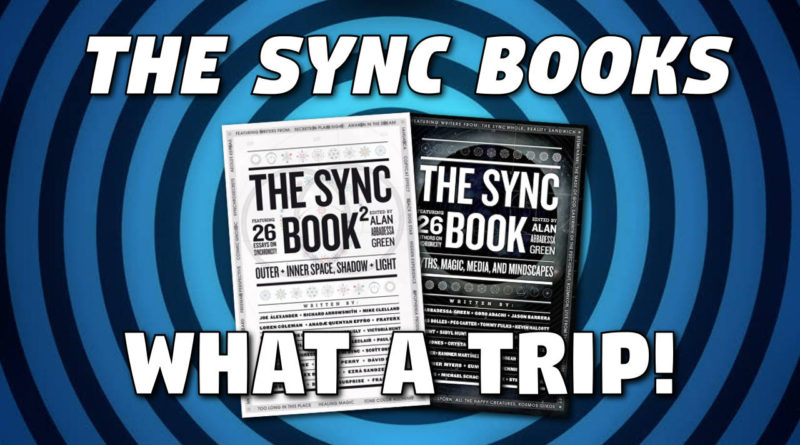
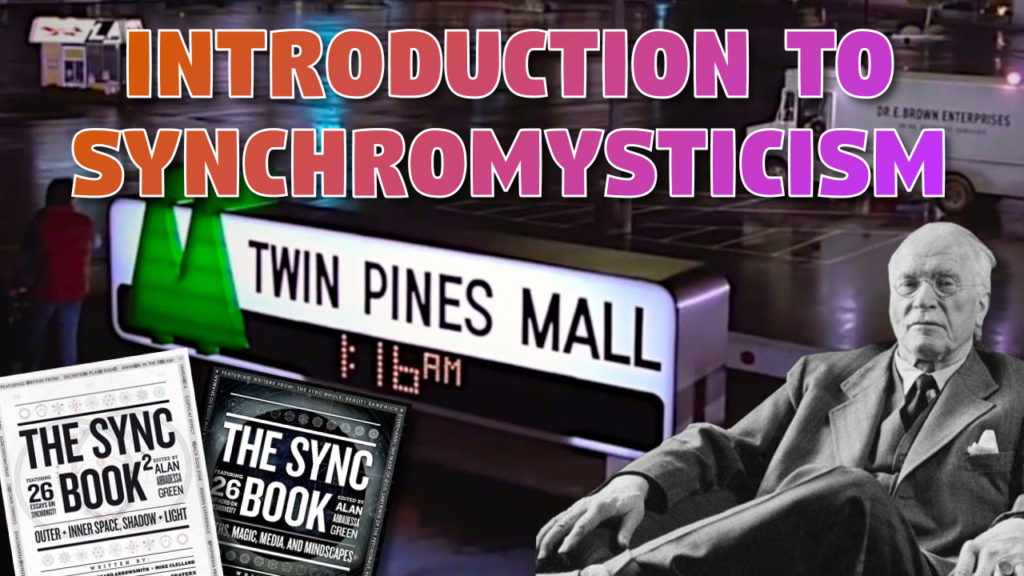
You have me listed as a “full member”, but my full membership expired on 10-21-17, about halfway through the 12 week challenge (6 months after my 34th birthday on 6-21-17, numbers!!).
Before it expired I had been considering taking a break from visiting the website. When it expired surprisingly I took it as a cue from God to take a break.
4 months, not 6 months, oh well.
lol, that 5 minute timer on editing for every comment has me editing down to the wire
You may not recall but a few months ago you sent through some money to my paypal account, and so I have credited you as having paid your membership forward for a commensurate period of time (i.e. total sum / 20 = months paid forward). If you would like me to remove you from the Full Member credit list for any reason, simply let me know and I will take care of it. As far as I am concerned, however, your contribution ought to be recognised. Ultimately it is your decision and I will oblige either way.
By the way, I know you bought copies of The Sync Books for yourself so I would be very interested to read your own perspective on the books and the experience of reading and thinking about them.
I remembered all that about the subscription, that was cool, I was just surprised the time went so quick and I wasn’t expecting it to run out so soon.
I haven’t read the second book yet. I will write you something about the sync books, it will be one of my top priorities, I owe it to you for helping me with your challenge.
Maybe I’m finding ‘easter eggs’ John, in your archive …as I trawl/vel
It… Like Bruce I’m sent back to get something to sort out this dreadful present where mostly life is underground and must be protected from the deadly life above ground. I have to decontaminate after each trip back.. I am a drooling wreck in an insane asylum waiting for Brad like McMurphy for Chief Broom … To pass me the 🔐 …I find the Moonkey deeper than it was when I first read this post 6m ago… And yours with Welensky it’s all a joke plus that clown story I remember first reading it 60 yrs ago in Wide Range Readers learning to read out in Africa 🌍
Chris marker was an obscure french auteur made films of ‘his’ own reality, not cinema vérité as other filmmakers…
Your ‘joke’ is very good imho I repeat succinct intro …
‘Moonkey’ is on a different scale I saw 2001 on release it’s been fundamental to my world since … I now begin to see 🙈😀
Cheers
I’ve never seen the Back to the Future Predicts 9-11 very interesting. As I was watching the second video and monkey was coming up I was thinking of Loki, and it tied right into your joke video. I’ve been listening to North Mythology audio books at night (Not the Marvel version) and Loki is a very interesting character.
He starts off relatively good. He plays tricks and jokes but he never means to hurt anybody with them. He generally tries to help the people in some way while playing practical jokes or mocking them. He lives among the gods but isn’t really one of them. His tricks reminded me of the Principia Discordia, and this idea pranks are pulled and chaos is used to bring about some order and social change.
I was looking into the history of north mythology and learned, I think most of it comes from two main sources. One of the guys was Saxo Grammaticus and the book was called Gesta Danorum.
Well they don’t have the whole book they only have like 4 sections of it.
The Angers Fragment, is four parchment pages found in 1877.
The Lassen Fragment, is one parchment page with two sides 1860
The Kall-Rasmussen Fragment, two pages four sides found 1855
The Plesner Fragment, one page two sides found in 1877
The rest I guess was taken from the Compendium Saxonis. I couldn’t find where and when this book was found or stored for the last 800 years.
The second source is the Codex Regius was said to be written in 1270 went missing for 373 years, where it ended up in the hands of a king, and kept in the Royal Library in Copenhagen until April 21 1971.
The Oxford dictionary says Lo is used to draw attention to an interesting or amazing event.
Ki or key is used to open a lock or a door.
I also found there is a Sumerian god called Ki and she represents earth.
I don’t know if any of this helps or is of interest, it’s just some of my thoughts while reading this.
http://www.sacred-texts.com/neu/poe/poe.pdf
I thought this looked interesting… In the Poetic Edda or Codex Regius p. xvi under WHAT IS THE POETIC EDDA
“From all this it is evident that the Poetic Edda, as we now know it, is no definite and plainly limited
work, but rather a more or less haphazard collection of separate poems, dealing either with Norse
mythology or with hero-cycles unrelated to the traditional history of greater Scandinavia or Iceland. How many other similar poems, now lost, may have existed in such collections as were current in Iceland in the later twelfth and thirteenth centuries we cannot know, though it is evident that some poems of this type are missing. We can say only that thirty-four poems have been preserved, twenty-nine of them in a single manuscript collection, which differ considerably in subject-matter and style from all the rest of extant Old Norse poetry, and these we group together as the Poetic Edda.”
The part where it says 34 poems have been preserved, 29 of them in one book, which differ considerably in subject matter and style from all the rest of the Old Norse Poetry that still exist.
If Im reading this right it differs in subject matter and style compared to any other poems at the time, then how can it be from that time?
Just ordered Sync Book 2 through your link, have a coffee on me lol.
Thanks 🙂 If only the Amazon Affiliate program worked like that. Turns out that you need to generate $X in a given month to qualify for payouts. In other words, even though several people have used that Affiliate link, to date I have received $0.00 from Amazon. Just how it is.
Be sure to let us know what you think of the second Sync Book. The two Sync Books are, in my opinion, rather different from one another.
People are Lemmings John: Based on 1958 prog
‘White Wilderness’ by Uncle Walt
“It remains unknown whether or not Walt Disney was aware or approved of this practice.” lol
https://www.youtube.com/watch?v=xMZlr5Gf9yY
https://en.wikipedia.org/wiki/White_Wilderness_(film)
‘Moonkey’ by StArmy (a production of Jake Kotze)
Beautiful. Simply beautiful. Brought me to fucking tears. Thank you for sharing this beautiful production.
Winston
Maybe I’m finding ‘Easter eggs’ John, in your archive …as I trawl/vel
It… Like Bruce I’m sent back to get something to sort out this dreadful present where mostly life is underground and must be protected from the deadly life above ground. I have to decontaminate after each trip back.. I am a drooling wreck in an insane asylum waiting for Brad, like McMurphy for Chief Broom to pass me the 🔐 …I find the Moonkey deeper than it was when I first read this post 6months ago… and looked at synch books cos I was totally knocked out by your story of the kids on the Brisbane train. Your real name!
Welensky it’s all a joke – that clown story I remember first reading it 60 yrs ago in Wide Range Readers learning to read out in Africa – where the ‘biggest’ politician was called Welensky= all so personal!
Chris Marker was an obscure french auteur made films of ‘his’ own reality, not cinema vérité as other filmmakers… wrote La Jetee 1962!
Your ‘joke’ is very good to repeat succinct intro … now moving on from black Pill days onto honk pill. A breath of fresh air! Relax enjoy the ride
Maybe don’t have sch a mass weighty baggage from now.? It’s all about making my own realito- clowning about is SCARY to some…
Cavendish and gravity and Scientism etc all such a downer, man!
‘Moonkey’ is on a different scale as others say; I saw 2001 on release it was ground zero for my worldview … begin to see how much
Unforgettable NAT was so much a part of my life man!😀
Cheers JLB Have a lovely day